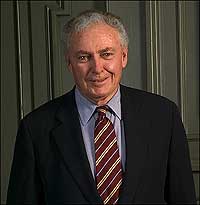Telling the Story
Every story worth the telling has a beginning, middle, and an end. In some of the most exciting and important stories, there is challenge, then struggle, and then resolution. Of these, my favorite is the story of the genesis of our republic, the story of how the founders thought up the idea of America, the story of how our nation launched its experiment in self-government.
The seeds of the nation sown in the wilderness of Jamestown Island bore fruit in the revolutionary city of Williamsburg, fruit harvested in the battlefields of Yorktown. Beginning, middle, and end. That is the story of Virginia's Historic Triangle, the story we will tell as we approach the 225th anniversary of the Yorktown victory in the autumn of 2006, and during the year-long commemoration of the 400th anniversary of Jamestown's founding in 2007.
It is a compelling story. It begins in 1607, when England makes woebegone Jamestown its first permanent New World settlement. Virginia's capital, Jamestown, survives a dozen years of privation and death before it summons the colony's burgesses to the first representative assembly in English America.
That government endures crisis upon crisis during the Jamestown era until, in 1699, it moves inland to Middle Plantation—aptly named for the purposes of this message. The lawmakers rechristen the place Williamsburg, a new capital for a new century where young men—George Washington, George Wythe, Thomas Jefferson, George Mason, Patrick Henry, and Richard Henry Lee, among others—gather to challenge royal government. They wrestle with Great Britain for their rights, and ultimately, in May of 1776, in the Capitol at the end of Duke Gloucester Street, declare first for separation.
It was a tumultuous time. There was action in Boston, New York, Philadelphia, and elsewhere, but at the end, the focus was on Virginia. From his Williamsburg headquarters at the Wythe House on Palace Green, General Washington rides in 1781 to the dénouement at Yorktown, where we and our French allies redeem by force of arms America's claim on independence.
What happened at Yorktown, what happened at Jamestown, are part and parcel of what happened at Williamsburg. That is what makes this year's celebration of the Yorktown siege and next year's commemoration of Jamestown's quadricentennial important to Colonial Williamsburg.
That is why we have launched our Education for Citizenship initiative—to tell in new and compelling ways the beginning, middle, and end of the story of how in those times American democracy was fashioned. It is why our Revolutionary City is programmed to portray events from 1774 to 1781, to carry the story from Williamsburg's Capitol to Yorktown's trenches, just as it made its way here from Jamestown.
What happened at Williamsburg is also part and parcel of what happened at Yorktown and Jamestown. The more we can do to integrate the programming at these sites, the more effective, the more relevant, the presentation of the story of the entire Historic Triangle will be. Beginning, middle, and end—that would make it a more coherent story, a more understandable story for the American citizen who, I fear, may not be hearing that story clearly enough.
That citizen would be the beneficiary, and so would be the Historic Triangle, if the historic sites worked more closely on the message, on the story told. That story and the importance to the nation of the Williamsburg-Jamestown-Yorktown destination would perhaps be more widely known and appreciated.
It makes little difference to which point on the triangle the citizen goes first to start to hear the story unfold. The linkage is what matters. Tightening those linkages would be a salutary goal for the commemorations that begin this year. Those linkages make the story more appealing, more persuasive, more gripping, and more accessible to guests of institutions all founded on the conviction that the future may learn from the past.
Colin G. Campbell
Chairman and President

